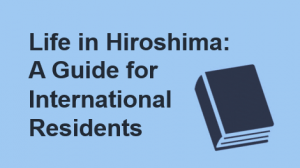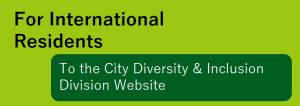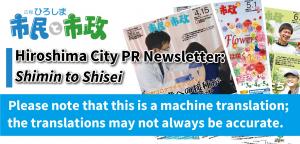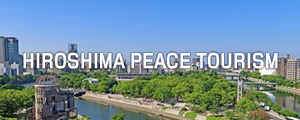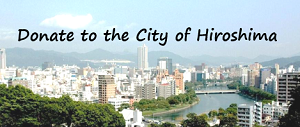本文
Promoting Initiatives for the Abolition of Nuclear Weapons
1. Fostering international and domestic opinion towards the abolition of nuclear weapons
(1) Holding atomic bomb exhibitions around the world
A-bomb exhibitions overseas
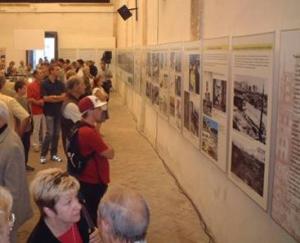 Since 1995, the 50th anniversary of the atomic bombing, we have held A-bomb exhibitions overseas to communicate the realities of the atomic bombing and raise international opinion in support of nuclear abolition through artifacts, photo panels, and hibakusha testimonies. In FY 2023, exhibitions will be held in Durham (UK) and Munich (Germany).
Since 1995, the 50th anniversary of the atomic bombing, we have held A-bomb exhibitions overseas to communicate the realities of the atomic bombing and raise international opinion in support of nuclear abolition through artifacts, photo panels, and hibakusha testimonies. In FY 2023, exhibitions will be held in Durham (UK) and Munich (Germany).
A-bomb exhibitions in Japan
In order to communicate the realities of the atomic bombing and raise public opinion in support of nuclear abolition, we have held A-bomb exhibitions comprised of artifacts, photo panels, and hibakusha testimonies in Japan one to five times a year since 1996. In FY 2023, exhibitions will be held in Sendai and Yamagata cities.
Lending and providing materials for A-bomb exhibitions and peace studies in Japan and abroad<外部リンク>
We lend and provide materials including A-bomb photo posters/panels and documentary films to communicate the damages caused by the atomic bombing and to raise awareness of peace both inside and outside of Japan.
(2) Support for establishing the Hiroshima-Nagasaki Peace Study Courses
We call upon colleges and universities home and abroad to establish Hiroshima-Nagasaki Peace Study Courses<外部リンク> to convey the experiences of the atomic bombings and the hibakusha wish for peace to younger generations. These are courses that, by approaching the bombings through academic disciplines, teach the realities of the atomic bombings of Hiroshima and Nagasaki, the inhumanity of nuclear weapons, the preciousness of peace, and more. We also support interested schools by sending lecturers and providing materials.
(3) Training for domestic journalists
This training program targets journalists for local papers. The program comprehensively and systematically covers topics such as damages caused by the atomic bombing, challenges for Hiroshima as an atomic bombed city, and the current global situation regarding nuclear weapons. Participants widely publish articles and editorials about atomic bomb-related topics.
(4) Promoting peace through welcoming visitors
1) Visits of world polycymakers
Visit of Pope Francis
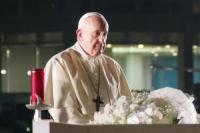
On November 24, 2019 Pope Francis became the first Pontiff to visit Hiroshima in 38 years, following Pope John Paul II in 1981. The Pope laid flowers before the Cenotaph for the A-bomb Victims and listened to testimonies from hibakusha firsthand to learn firsthand about the realities of the atomic bombing and the hibakusha wish for peace. He sent a message of peace to the world from Hiroshima, stating, "Here I pay homage to all the victims..." and "to remember, to journey together, to protect. These are three moral imperatives...”
Visit of US President Barack Obama<外部リンク>
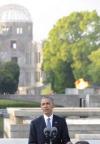
On May 27, 2016, President Barack Obama of the United States became the first sitting US President to visit Hiroshima. Through visiting the Peace Memorial Museum and offering flowers at the Cenotaph for the A-bomb Victims, we believe he understood the realities of the atomic bombing and hibakusha will for peace. The president reaffirmed his commitment to work for the abolition of nuclear weapons by stating in his speech, “…among those nations like my own that hold nuclear stockpiles, we must have the courage to escape the logic of fear and pursue a world without them.”
Visit of Prime Minister Kishida and US Ambassador to Japan Rahm Emanuel

On March 26, 2022, Prime Minister Fumio Kishida and US Ambassador to Japan Rahm Emanuel visited the Peace Memorial Museum and offered flowers at the Cenotaph for the A-bomb Victims, escorted by Mayor Matsui.
Visit of European Council President Charles Michel
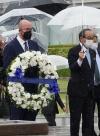 On May 13, 2022, European Council President Charles Michel visited the Peace Memorial Museum, offered flowers at the Cenotaph for the A-bomb Victims, and had a meeting with Mayor Matsui.
On May 13, 2022, European Council President Charles Michel visited the Peace Memorial Museum, offered flowers at the Cenotaph for the A-bomb Victims, and had a meeting with Mayor Matsui.
2) Hosting international conferences
G7 Foreign Ministers' Meeting in Hiroshima
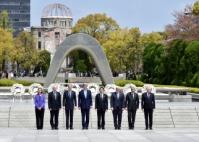 In 2016, Hiroshima hosted the Foreign Ministers' Meeting on April 10 and 11, prior to the G7 Ise-Shima Summit in May. We believe that the foreign ministers touched upon the realities of the atomic bombing and shared in our wishes for peace through visiting the Peace Memorial Museum and offering flowers at the Cenotaph for the A-bomb Victims.
In 2016, Hiroshima hosted the Foreign Ministers' Meeting on April 10 and 11, prior to the G7 Ise-Shima Summit in May. We believe that the foreign ministers touched upon the realities of the atomic bombing and shared in our wishes for peace through visiting the Peace Memorial Museum and offering flowers at the Cenotaph for the A-bomb Victims.
United Nations Conference on Disarmament Issues
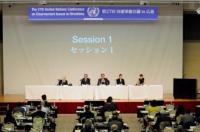 In November 2017, we hosted the 27th UN Conference on Disarmament Issues, where government officials from nuclear powers and countries which promote the Treaty on the Prohibition of Nuclear Weapons, as well as experts on disarmament issues, among others, discussed disarmament from various points of view. Prior to the conference, we also hosted the 1st meeting of the Group of Eminent Persons for Substantive Advancement of Nuclear Disarmament which was organized by the Japanese government.
In November 2017, we hosted the 27th UN Conference on Disarmament Issues, where government officials from nuclear powers and countries which promote the Treaty on the Prohibition of Nuclear Weapons, as well as experts on disarmament issues, among others, discussed disarmament from various points of view. Prior to the conference, we also hosted the 1st meeting of the Group of Eminent Persons for Substantive Advancement of Nuclear Disarmament which was organized by the Japanese government.
Meeting of International Group of Eminent Persons<外部リンク>
In December 2022, we hosted the first meeting of the International Group of Eminent Persons for a World without Nuclear Weapons which experts from Japan and abroad attended.
G7 Hiroshima Summit
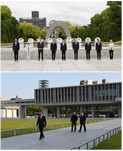 The G7 Hiroshima Summit was held in Hiroshima from May 19 to 21, 2023. Not only G7 leaders but leaders of invited countries and international organizatiions visited the Peace Memorial Museum, offered flowers at the Cenotaph for the A-bomb Victims, and had a dialogue with a hibakusha. We believe that the leaders touched upon the realities of the atomic bombing and shared in our wishes for peace. Ukrainian President Zelenskyy also attended the Summit and visited the Peace Memorial Museum, offered flowers at the Cenotaph for the A-bomb Victims, and had a dialogue with a hibakusha.
The G7 Hiroshima Summit was held in Hiroshima from May 19 to 21, 2023. Not only G7 leaders but leaders of invited countries and international organizatiions visited the Peace Memorial Museum, offered flowers at the Cenotaph for the A-bomb Victims, and had a dialogue with a hibakusha. We believe that the leaders touched upon the realities of the atomic bombing and shared in our wishes for peace. Ukrainian President Zelenskyy also attended the Summit and visited the Peace Memorial Museum, offered flowers at the Cenotaph for the A-bomb Victims, and had a dialogue with a hibakusha.
(5) Protest against nuclear testing
Since 1968, the City of Hiroshima has sent protest letters to countries which conduct nuclear tests. We also send letters of protest or request in response to various nuclear weapons issues.
2. Enhancing and strengthening Mayors for Peace
(1) Activities by Mayors for Peace
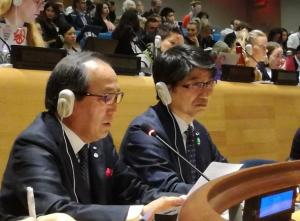 In order to achieve a world in which all people can perpetually benefit from peace by realizing the total elimination of nuclear weapons and by attaining and maintaining peaceful coexistence between the whole of humanity, Mayors for Peace<外部リンク> has adopted the Vision for Peaceful Transformation to a Sustainable World (PX Vision) and Mayors for Peace Action Plan (2021-2025) at the 12th Executive Conference in July 2021. Based on this vision, its member cities are implementing initiatives for a world without nuclear weapons, as outlined in the action plan.
In order to achieve a world in which all people can perpetually benefit from peace by realizing the total elimination of nuclear weapons and by attaining and maintaining peaceful coexistence between the whole of humanity, Mayors for Peace<外部リンク> has adopted the Vision for Peaceful Transformation to a Sustainable World (PX Vision) and Mayors for Peace Action Plan (2021-2025) at the 12th Executive Conference in July 2021. Based on this vision, its member cities are implementing initiatives for a world without nuclear weapons, as outlined in the action plan.
Mayors for Peace has also carried out petition drives calling for all states to join the Treaty on the Prohibition of Nuclear Weapons at the earliest date and has collected 3,180,000 signatures* as of June1, 2023. Of them, 290,000 signatures were submitted to Ms. Izumi Nakamitsu, UN Under-Secretary-General and High Representative for Disarmament Affairs during the First Meeting of States Parties to the Treaty of the Prohibition of Nuclear Weapons in June 2022.
*The above number includes signatures collected through the petition drive calling for negotiations for a nuclear weapons convention, which Mayors for Peace has promoted since December 2010.
Moreover, every year since 2012 the Japanese member cities of Mayors for Peace have submitted a letter of request to the Japanese government calling for the promotion of actions to abolish nuclear weapons.
(2) The 10th Mayors for Peace General Conference
Mayors for Peace holds a general conference every four years for its member cities to gather to make a final resolution of approval on important issues for the abolition of nuclear weapons and lasting world peace.
The 10th General Conference which was held in Hiroshima in October 2022 adopted the Hiroshima Appeal demonstrating their determination to build peace by strengthening solidarity among its member cities.
(3) Mayors for Peace internship program
We invite young officials from overseas member cities to work as interns at the Mayors for Peace Secretariat in Hiroshima. By having them deepen their understanding of Mayors for Peace initiatives, we are striving to strengthen collaboration with our member cities.
3. Drawing up and disseminating the Peace Declaration
The mayor of Hiroshima delivers a Peace Declaration at the Peace Memorial Ceremony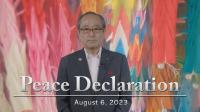 every year on August 6 to convey to the world the Will of Hiroshima, which calls for the abolition of nuclear weapons. To disseminate the declaration, the Japanese original and the English translation are sent to various entities including all foreign embassies in Japan, the permanent mission of each country to the United Nations and the member cities of Mayors for Peace. In addition to the English version, the declaration is translated into nine different languages and disseminated widely via the Internet and other means. Moreover, a video of the mayor delivering the Peace Declaration in English is publicized on our city's official website so that his message of peace may reach farther and wider around the globe.
every year on August 6 to convey to the world the Will of Hiroshima, which calls for the abolition of nuclear weapons. To disseminate the declaration, the Japanese original and the English translation are sent to various entities including all foreign embassies in Japan, the permanent mission of each country to the United Nations and the member cities of Mayors for Peace. In addition to the English version, the declaration is translated into nine different languages and disseminated widely via the Internet and other means. Moreover, a video of the mayor delivering the Peace Declaration in English is publicized on our city's official website so that his message of peace may reach farther and wider around the globe.
4. International Symposium for Peace
Every year we hold the International Symposium for Peace with participation of nuclear issues experts in Hiroshima or Nagasaki, alternatively, in order to raise citizens awareness of peace. In FY 2022, a symposium was held in Nagasaki, along with live streaming.
5. Hosting UN Disarmament Fellows
Since 1983, we have been hosting participants of the UN Disarmament Fellowship program<外部リンク>, which educates diplomats to become disarmament specialists. We provide them with an opportunity to deepen their understanding of the damage caused by the atomic bombing.
6. Peace Education Webinar
Mayors for Peace holds Peace Education Webinars online with participation of young people from its member cities home and abroad. They make presentations of their programs and exchange opinions after inheriting the experiences of wars and atomic bombings and wishes for peace.
7. Training session in Hiroshima for United Nations tour guides
We invite tour guides and concerned officials from United Nations facilities which house permanent A-bomb exhibitions for a training session to learn about the realities of the atomic bombing.



